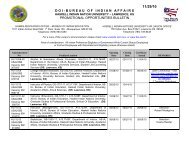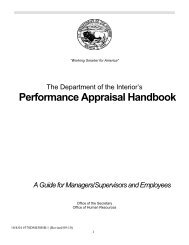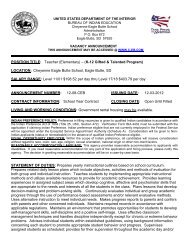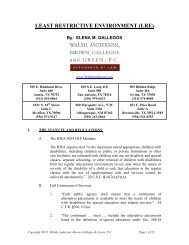BIE 2009-2010 Baseline Data Report Kingsbury-NWEA - Bureau of ...
BIE 2009-2010 Baseline Data Report Kingsbury-NWEA - Bureau of ...
BIE 2009-2010 Baseline Data Report Kingsbury-NWEA - Bureau of ...
- No tags were found...
You also want an ePaper? Increase the reach of your titles
YUMPU automatically turns print PDFs into web optimized ePapers that Google loves.
DISCUSSIONMEASURING PERFORMANCE FOR <strong>BIE</strong> STUDENTSThe main way this report is different from other types <strong>of</strong> performance reports is that it measures actual student growth,not just whether student performed above a particular state’s cut score. In addition, MAP tests measure the level <strong>of</strong>subject matter knowledge in reading and math that a student has attained, not simply whether they have met a gradelevelstandard. <strong>BIE</strong> students have <strong>of</strong>ten not passed state AYP measures and are mislabeled with the term “failing.”Achievement for the educational system should be measured on student growth, particularly for students who arebehind others, so successes can be measured, encouraged, and increased. The <strong>Bureau</strong> <strong>of</strong> Indian Education hasrecognized this fact in its partnership with <strong>NWEA</strong> to help schools and students to understand what it takes for studentsto improve and to see what it looks like when they do. This Project is early in its inception, but the rigorousmeasurement <strong>of</strong> student performance will, over time, allow the <strong>BIE</strong> to identify successes as well as challenge areas thatneed more attention.SUMMARY OF FINDINGSThe average starting Fall RIT scores for students in <strong>BIE</strong> Project schools were lower than non-Project school students,possibly because schools were chosen for the Project based on student performance. The average for <strong>BIE</strong> students—Project, non-Project, and overall—was lower than the national norms provided by <strong>NWEA</strong>. <strong>BIE</strong> students lagged more inReading than in Math.There were two main growth comparisons used in this analysis. The Norm Indexed Growth Score shows whether a group<strong>of</strong> students is above or below the national growth rate for students with the same starting score. The VCG IndexedGrowth Score shows whether a group <strong>of</strong> students is above or below the growth rate for a group <strong>of</strong> students similar tothem in starting score, school poverty rate, and geographical location (urban or rural). The Norm Index puts all studentson an equal measurement with students in other grades and states, but the VCG Index further refines the comparison toschools that face similar challenges to <strong>BIE</strong> schools.Average <strong>BIE</strong> school Fall to Spring growth scores were lower than the national norm sample, as indicated by the negativeNorm Growth index Score. <strong>BIE</strong> students averaged across all grades had similar performance to their VCG groups. Bygrade, <strong>BIE</strong> students were generally lower than their VCG group in early grades K-7 and higher than their VCG group inlater grades 8-12. 2 nd and 8 th grade Math and 9 th grade Reading showed particularly high growth for <strong>BIE</strong> studentscompared to their comparison groups. The same pattern was true for students in the <strong>BIE</strong> Project.Statistical significance tests show which differences truly reflected a difference between student groups and weren’t justdue to random chance. This is particularly important to measure when only one year <strong>of</strong> growth data is available and atrend cannot be established. Unfortunately, statistical significance also depends on the number <strong>of</strong> students in eachgroup; with a small number <strong>of</strong> students, differences cannot be identified with certainty. The pattern for these tests <strong>of</strong>significance was generally consistent: <strong>BIE</strong> students showed less growth than their virtual comparison groups in Math forthe total across all grades and specifically for grades, grades 3, 5, 6 , and also in Reading grades 3-6. <strong>BIE</strong> students showedstatistically more growth than their comparison groups in Math in 8 th and 9 th grade, and in Reading in 9 th and 10 th grade.Some <strong>of</strong> these differences, while showing a strong statistical significance, may not result in a meaningful difference. Forinstance, the difference between the <strong>BIE</strong> student average and the comparison group average in 4 th grade Math was .65norm indexed growth points. A half <strong>of</strong> a RIT point less growth in the 4 th grade will put the student at a significantdisadvantage if sustained over several years, but can also be recovered within a school year.31 | P a g e
















